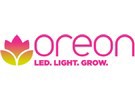It is often heard in the market that LED lights produce no heat radiation. This is often stated to differentiate between LED and High Pressure Sodium lights. An HPS light will convert around 80-90% of the electrical energy into radiation. Of this radiation, roughly 50% will be PAR light and the other 50% will be in the infrared part of the spectrum, often referred to as "heat radiation". An LED light on the other hand, will convert roughly 60% of the electrical energy into PAR light, and the remaining 40% is converted into heat that conducts away through the back side of the LED.
What is heat radiation?
Heat radiation is not a scientific term. All types of radiation including PAR light and infrared light are a form of electromagnetic radiation. Radio waves and X-rays are also a form of electromagnetic radiation; the only difference between these types of radiation is the wavelength. The picture below shows how the electromagnetic spectrum is divided into different categories.

All forms of electromagnetic radiation are capable of heating an object, as long as that object absorbs that specific wavelength of radiation. The microwave oven is able to heat up your food, but so is the light from the sun, even though they have totally different wavelengths. As long as the object will absorb radiation at that specific wavelength, it will be heated by that radiation.
We can look at the absorption spectrum of several types of plants, to see how certain types of radiation can affect heating of that plant. The figure below shows an example of the absorption spectrum of various vegetables.

This figure also shows that there is not much light absorbed in the range of 700-1200nm. In the PAR range (400-700nm) nearly all light is absorbed, especially at the blue and red ends of the spectrum (450nm and 660nm). It can be concluded that PAR light not only causes photosynthesis in a plant, but will also heat up the plant leaf surface by radiation.
Of the total consumed power of an HPS light, 40% of the energy is converted into PAR and 40% into Near Infrared (NIR). Of this NIR, 50% is not absorbed by the plant and can be considered lost. Therefore, 60% of the consumed power of the fixture is absorbed by the plant, and can be turned into heat.
For an LED fixture, 60% of the consumed power will become PAR radiation, which is nearly all absorbed by the plant, especially if the spectrum is a combination of red and blue LEDs. This is the same percentage as with an HPS fixture.
It is observed that in a greenhouse, a plant illuminated under an HPS light will be 1-2 degrees warmer than when lighted with LED. The reason for this is that when comparing LED to HPS, typically the PAR photon flux is kept the same. This requires less power for an LED fixture, and therefore less radiation will arrive at the plant. If more heat is required, several options exist to increase the temperature:
- Increase the light level.
- Recover the heat from the fixture (water cooling) and apply to the plant.
Conclusion
It is not true that LED light causes no heating of the plant, however, the amount of heat is significantly less compared to an HPS fixture. Several ways exist to increase the amount of heat if this would be necessary. However, LED poses an even bigger benefit in the opposite case, when there is too much heat when using HPS. Much higher light levels are possible with LED without overheating the greenhouse and/or the plant.
For more information:
Oreon
Lorentzlaan 6
3401 MX IJsselstein
Netherlands
T: +31 30 760 0660
E: info@oreon-led.com
www.oreon-led.com
